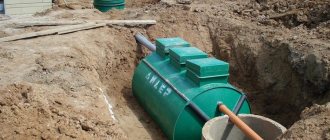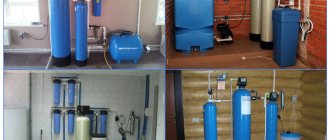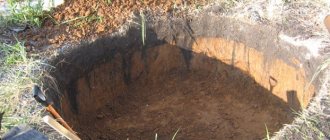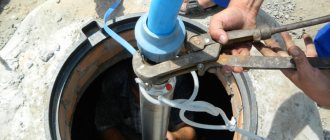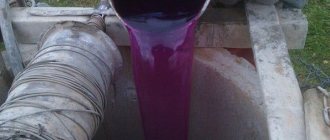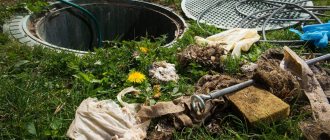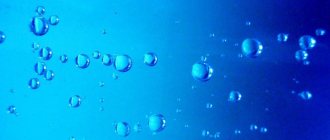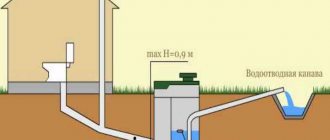Why does water from a well, boiler, well or pipe smell like hydrogen sulfide?
Water from a well, boiler, well or pipes may suddenly begin to smell of hydrogen sulfide. The smell is identical to that of "rotten eggs". The reason for the smell of hydrogen sulfide is the proliferation of bacteria in the water. Water from the city water supply is usually specially prepared, highly disinfected, chlorinated, and such cases rarely occur with it.
Large amounts of hydrogen sulfide gas (H2S) are released and accumulated as a result of the activity of sulfate-reducing (sulfate-reducing) bacteria in water.
Sulfate-reducing bacteria (SRB) use organic matter (CH2O) or hydrogen (H) as an electron donor and sulfate (SO4) as an electron acceptor to produce energy
2CH2O + SO42- + 2H+ => 2CO2 + H2S + 2H2O
Simply put, there are two types of sulfate-reducing bacteria. Both varieties require sulfates - sulfur compounds - as well as hydrogen to survive. But one species of bacteria extracts hydrogen from organic matter in the sludge . Other bacteria use molecular hydrogen , which is found in water.
IMPORTANT ! The development of sulfate-reducing bacteria occurs under anaerobic conditions , in the absence of free oxygen in water.
Sulfates are salts of sulfuric acid H2SO4. For example, potassium sulfate K2SO4, sodium hydrogen sulfate NaHSO4. Sulfates are widespread in nature, forming a whole group of minerals. Many sulfates are soluble in water and are found in natural water.
Chemical disinfection
It is possible to oxidize hydrogen sulfide and thereby get rid of its smell in simpler ways. The oxidizing agent here is not air, but ozone and oxygen and chlorine contained in various compounds. As a result, it is possible to achieve the formation of insoluble inclusions, from which water can be purified by passing it through filters.
Chlorine cleaning
Chlorine cleaning at home is carried out only for preventive purposes, periodically filling wells or wells with quicklime. This requires closing the water intake for approximately 7-10 days. After standing and disinfecting the liquid source, it is washed by supplying a large amount of clean water from above and pumping it out. After this, a slight aroma of chlorine remains, which gradually disappears with constant use of the well.
The method is used to prevent the proliferation of sulfur bacteria at the bottom and walls of the water intake. It is often used seasonally to treat water sources after they have been preserved for a long time (for example, for the winter). Chlorination is not used in an operating well.
Water purification with chlorine gas, as on an industrial scale, is not carried out at home. The oxidation of hydrogen sulfide produces a colloidal form of sulfur. It is impossible to transform it into sediment and remove it with household filters.
Cleansing with ozone and hydrogen peroxide
Ozone, or atomic oxygen, actively oxidizes hydrogen sulfide. An easy way to get it at home is to add pharmacy hydrogen peroxide. The drug decomposes into water and atomic oxygen, and the gas turns into insoluble sulfur compounds (sulfates, sulfur, etc.), which can be removed using a filter. The use of peroxide does not change the taste or color of water, but it effectively removes unpleasant odors.
Scheme for purifying water from a well with ozone.
Cleansing with potassium permanganate
Potassium permanganate is another available reagent that will remove hydrogen sulfide contamination. It also has disinfecting properties and can destroy bacteria if the cause of the odor is their proliferation. Add pharmaceutical potassium permanganate until a light pink color appears. After this, the liquid is filtered twice using carbon sorbents.
Scheme of a water deoxidizer that uses potassium permanganate as a reagent.
During such treatment, water has to be collected in containers and disinfected in them. This makes it impossible to use the water supply in the traditional way.
Iodine solution
A pharmaceutical solution of iodine also has oxidizing properties, allowing the gas to be converted into insoluble compounds. To clean with iodine, add 2 tsp to 1 bucket of water (10 l). pharmaceutical drug. Carbon filters will remove the iodine aroma.
Why is hydrogen sulfide dangerous?
Hydrogen sulfide (H2S) is poorly soluble in water. Flammable. The concentration limits of ignition in a mixture with air are 4.5-45% hydrogen sulfide.
Hydrogen sulfide is very toxic. Inhaling air with a small content of hydrogen sulfide causes dizziness, headache, nausea, and with a significant concentration it leads to coma, convulsions, pulmonary edema and even death. At high concentrations, a single inhalation can cause instant death . When inhaling air with small concentrations, a person quickly adapts to the unpleasant smell of “rotten eggs” and it ceases to be felt. A sweetish metallic taste appears in the mouth.
When inhaling air with a high concentration due to paralysis of the olfactory nerve, the smell of hydrogen sulfide almost immediately ceases to be felt. Hydrogen sulfide is also used for medicinal purposes, in hydrogen sulfide baths.
The appearance of hydrogen sulfide in water is not only an unpleasant odor and a health hazard. A solution of hydrogen sulfide in water is a very weak hydrogen sulfide acid. Hydrogen sulfide turns water into an acid , albeit a very weak one.
Increasing the acidity of water, for example, accelerates electrochemical corrosion of metals in plumbing and plumbing equipment.
Various methods
There are three groups of methods that most effectively remove hydrogen sulfide:
- physical - aeration;
- chemical - oxidation with hydrogen peroxide, sodium hypochlorite, ozone;
- physico-chemical - sorption with catalytic activated carbon, permanganate green sand and other filter media.
First aid
If you smell or taste hydrogen sulfide, first do the following:
- Remove sludge from the bottom of the well and from the walls of the pipes. Perform this cleaning once every 2 years.
- Pump the well.
- Remove the layer of clay and sand.
- Seal the pipes or replace them.
- Clean water heating devices (boiler).
This will remove the breeding ground for sulfate-reducing bacteria and stop the formation of hydrogen sulfide. Afterwards, you can begin direct cleaning of hydrogen sulfide.
Aeration
The method is suitable for removing molecular hydrogen sulfide H2S. HS- ions are partially filtered, but S2- ions remain.
The efficiency of aeration is average - the method dissolves 65-70% of hydrogen sulfide. Complete removal is only possible when the water is acidified to a pH less than 5.
The essence of the method: water is saturated with oxygen, which reacts with hydrogen sulfide and splits it into sulfur and water. Iron, manganese, and ammonium are also oxidized in parallel.
There are 2 types of aeration installations:
- Non-pressure - contact containers with sprayers, operating like a shower. Oxygen dissolves evenly in drops of water and reacts with most of the hydrogen sulfide. The system can be equipped with a low-power compressor that mixes the water to saturate it with oxygen. Oxidized substances precipitate, so the storage tank needs to be cleaned 2-4 times a year.
- Pressure - special columns or static mixers into which an oxygen mixture is supplied under pressure. After mechanical filtration, the water enters the pressure unit, and intensive oxidation occurs there. This kills anaerobic bacteria.
The advantages of this method are as follows:
- cheapness;
- good efficiency.
Minuses:
- the systems are bulky and take up a lot of space;
- they need to be cleaned regularly;
- the room where aeration occurs smells unpleasant.
Oxidation
Dosing units feed one of the strong oxidizing agents into the filter column at certain intervals:
- Sodium hypochlorite . The compound breaks down hydrogen sulfide into sulfuric acid and sulfur, transforms organic compounds, oxidizes iron and manganese. Disadvantage of the method: hypochlorite concentrate must be diluted only with distilled water; the substance also forms toxic chlorine derivatives.
- Hydrogen peroxide. A safe and effective household oxidizer supplied by a reagent dosing station.
- Ozone. It is produced from the air by special systems that are connected to the water supply.
Ozone oxidizes almost 90% of hydrogen sulfide and dissolved iron, turning them into an insoluble precipitate. It also kills viruses and bacteria.
Advantages of the method:
- high cleaning efficiency;
- safety while following all rules.
Minuses:
- you need to periodically buy reagents, but they are not cheap;
- installations are expensive and energy-consuming.
Sorption
Water is passed under pressure through charcoal or activated carbon. Exchange reactions occur on the surface of these materials, as a result of which H2S molecules oxidize and break down into safe substances (sulfur and its compounds), and all harmful compounds are absorbed by the porous surface.
One of the most popular filter materials is Centaur catalytic carbon (USA). It purifies water from:
- hydrogen sulfide,
- gland,
- chloramines,
- petroleum products.
Coal gives water a pleasant taste and smell. Centaur is used if the concentration of hydrogen sulfide in water is not more than 6.0 mg/l. Loading removes almost all hydrogen sulfide, but contact time must be at least 3 minutes .
Before supplying water to the filter, the water must be aerated; for this purpose, compressors or ejectors are used. The load is washed with a countercurrent of water; no special reducing agents are needed.
Another good filter media is manganese green sand (Manganese Greensand).
This is a manganese zeolite, which is obtained by processing the natural mineral glauconite.
On the active surface, hydrogen sulfide is oxidized to sulfur and sulfates. The resulting residue is filtered with a layer of granular material. A 28 liter bag lasts for 3 years or more.
Advantages of the method:
- extraction of 98% hydrogen sulfide;
- comprehensive water purification and deodorization;
- processing large volumes of liquid.
Minuses:
- sorbents are expensive;
- you need a lot of water for washing;
- low filtration rate.
Three sources of hydrogen sulfide in water
Bacteria in sludge cause hydrogen sulfide odor
The nutrient medium for some varieties of sulfate-reducing bacteria is sludge, which contains organic compounds. Such bacteria are present in nature, for example, in silt deposits at the bottom of swamps and lakes. Or in artificial structures - in a sewer septic tank, for example. Either at the bottom of the well, or in the well, if organic contaminants accumulate there.
At the bottom of the well, in the aquifer lens of the well, in the storage tank or in the boiler tank, over time, a layer of silt settles and accumulates from the water, which can become a habitat for sulfate-reducing bacteria.
Water from a well or well is often supplied to the house by pump. In this case, an autonomous water supply system usually has a non-pressure storage tank or a membrane accumulator, as well as other vessels - filters, for example. In all these vessels, sludge accumulates, in which SRB can settle. The cause of the smell of hydrogen sulfide in water flowing from taps may not be a well or well, but rather vessels in the water supply system of the house.
Bacteria in water is another cause of odor.
Other species of SRB live in water. To survive, such bacteria require molecular hydrogen . This type of bacteria can also be found in natural water. Some of them live in natural thermal water sources at a temperature of +110 °C.
The influx of hydrogen sulfide water from outside is the third cause of the smell
Water containing hydrogen sulfide may flow into a well or borehole from outside. The saturation of water with hydrogen sulfide occurs somewhere else. For example, bacteria live in an abandoned well on a neighboring property. And water from there comes into your well, already saturated with harmful gas.
In order to get rid of the smell of hydrogen sulfide, the most effective way is to eliminate the cause - to eliminate the conditions for the life and reproduction of sulfate-reducing bacteria.
In a well, well, or water tank, sulfate-reducing bacteria may be present in both sludge and water at the same time. But usually, one type of bacteria is the most active. Depending on what type of SRP is the cause of the hydrogen sulfide smell, the method of getting rid of bacteria is chosen.
In some cases, it is not possible or too expensive to get to the place of residence of the SLO and deprive them of their lives there. For example, bacteria live in the water intake lens of a well. And from there comes water already saturated with harmful gas. Reworking a well is expensive. In this case, you have to fight not bacteria, but use methods to neutralize the gas dissolved in water.
What is the best method for removing hydrogen sulfide?
Users of independent forums and thematic portals claim that non-pressure aeration with deposition on a granular coating is most effective in combating hydrogen sulfide. But you can choose the best equipment option only after carefully studying the composition of the water. The staff (Tyumen) will help you get detailed advice. They are engaged in the development of water treatment technologies, station design, installation and commissioning activities, as well as the sale of filters.
How to remove the smell of hydrogen sulfide from hot water boiler
In the boiler tank, over time, a layer of sludge settles from the water and accumulates at the bottom, which can become a habitat for sulfate-reducing bacteria.
But most often, the reason for the appearance of hydrogen sulfide in the boiler is the proliferation of SRP in the boiler water.
The fact is that molecular hydrogen is released especially intensively in the water heater tank if the protective corrosion protection operates in the “overprotection” mode.
If the water in the water heater tank contains a sufficiently large amount of sulfates, and the protective protection operates in the “overprotection” mode, with intense hydrogen release, then conditions are created for the active proliferation of sulfate-reducing bacteria in the water.
Determining the cause is not difficult - remove the sacrificial anode from the tank and turn on the water heater without the anode. If the water no longer smells like rotten eggs, the reason has been found.
Elimination of bacteria that live in the boiler in the sludge layer
It may be enough to do at least one of the following:
- The easiest way is to raise the water temperature above 70 °C and use this water for three days until the smell disappears. In the future, constantly keep the water temperature in the boiler above 55 ° C. It is recommended to periodically increase the temperature above 70 °C.
- Regularly clean the boiler to remove scale and sludge deposits on the bottom.
- Take measures to reduce the amount of organic contaminants in tap water that enters the boiler. To do this, you can change the water intake horizon - instead of a well, take water from a well. Install filters to purify tap water from mechanical and organic contaminants.
Eliminating bacteria from boiler water
To suppress sulfate-reducing bacteria living in boiler water, it is often enough to do the following:
- Try raising the water temperature above 70 °C and using this water for three days until the smell disappears. In the future, constantly keep the water temperature in the boiler above 55 ° C. It is recommended to periodically increase the temperature above 70 °C. But this method does not always help. Bacteria living in boiler water are often resistant to these temperatures.
- The activity of sulfate-reducing bacteria is suppressed if the molecular hydrogen content in water is reduced. For this purpose, the operating mode of the tread protection is optimized. Replacing a magnesium anode with an aluminum one reduces the hydrogen content in water , as it eliminates “overprotection”.
For information on replacing anodes, read: “Magnesium or aluminum anode for a water heater.”
General measures to combat bacteria in the boiler
The following measures can suppress the development of bacteria in both water and sludge:
- Aeration, air saturation, of tap water supplied to the boiler leads to an increase in the content of free oxygen in the water. As a result, the anaerobic habitat of bacteria changes to one less favorable for their life.
- Disinfect tap water using methods whose antibacterial effect persists for a long time after treatment - chlorination, etc. Ultraviolet water treatment is not suitable for this.
- Take measures to reduce the amount of soluble sulfur compounds in tap water. To do this, you can change the water intake horizon - instead of a well, take water from a well or deepen the well. These measures should be selected after testing the water source for sulfate content.
Hydrogen sulfide in a well most often appears as a result of the activity of bacteria, the nutrient medium of which is the organic substances in the sludge at the bottom and on the walls of the well shaft.
First of all, it is necessary to take measures to reduce the amount of organic contaminants in well water. These contaminants usually enter the water from the surface of the earth.
Such measures include the following:
- Do not leave the well open;
- Maintain a distance of at least 20 meters from the well to the sewerage system;
- Reliably seal the walls of the well from the penetration of water from the surface of the earth and the perched water;
- Use submersible pumps with remote injectors, this significantly reduces the number of leaks;
- Carry out regular preventive maintenance by disinfecting the well shaft with chemicals, cleaning the well from silt deposits, and replacing the filter stone backfill at the bottom.
However, these measures may not be enough. I recommend doing one of the following two things:
Aeration, saturation with air, of water directly in the well leads to an increase in the content of free oxygen in the water. As a result, the anaerobic habitat of sulfate-reducing bacteria changes to one less favorable for their life.
In addition, aeration reduces the content of iron and manganese compounds dissolved in water. The process of deferrization of water occurs. As a result of the saturation of well water with oxygen, the divalent iron dissolved in the water is oxidized to the ferric hydroxide form in the form of solid particles suspended in the water. The particles slowly fall out into a red-brown precipitate. Or they are extracted with water by a pump and retained by a fine-pored filter.
In the same way, during aeration, by oxidation to insoluble sulfur, hydrogen sulfide, which entered the well with water from the outside, is removed from the aquifer.
Kit for aerating water in a well: membrane compressor, aerator with a capacity of 20-60 l/min, tubular aerators, distribution comb
A membrane air compressor aerator supplies air, which is sprayed into fine bubbles through a layer of water in the well. The compressor operates periodically and is controlled by a time relay.
The dispenser with chemicals for the pool is also convenient to use for disinfecting water in the well.
The water directly in the well is continuously disinfected in order to suppress bacteria - chlorinated. To do this, it is convenient to use a special dosing cartridge, inside of which chlorine-containing calcium hypochlorite is placed. The cartridges are made of ceramic and are designed to hold different amounts of disinfectant. To disinfect water, the cartridge is immersed in water. Due to the porosity of the cartridge walls, active chlorine enters the well water. The disinfectant filling in the cartridge is changed as it is used up. The presence of residual chlorine in water is determined qualitatively - by smell or using the iodometric method.
On sale you can find and use dispensers and chemicals for similar purposes to disinfect water with chlorine in swimming pools.
One of the disadvantages of constant chlorination is that the chlorinated water eventually ends up in the sewer septic tank, where the chlorine in the water suppresses the already beneficial bacteria that decompose organic matter in the drain.
Disinfection of mine wells and disinfection of water in them is carried out in accordance with the “Temporary Instructions for the disinfection of mine wells and disinfection of water in them”, approved by the Main Sanitary and Epidemiological Directorate of the USSR Ministry of Health on January 18, 1967 N 663-67.
Purifying water from dihydrosulfide: choosing a filter
Most modern filtration purification systems include units for removing hydrogen sulfide. Most often, cleaning occurs in a complex manner using aeration, oxidation and sorption.
Below is a description of several ready-made systems.
Ecvols water purification systems standard
Designed for comprehensive cleaning of contaminants, including removing hydrogen sulfide. The system consists of a deferrization filter, a sorption filter and a reverse osmosis design.
How to get rid of hydrogen sulfide in well water
Location of aquifers for water intake for water supply
Drilling a well violates the integrity of the upper layers of soil above the aquifer. It is not always possible to restore their tightness when constructing a well. As a result, water from the surface or high water pollutes the water intake layer with organic substances.
Around the well, in the water intake layer, a small lake is formed, from 2-3 m in diameter to 40-50 m, called a lens.
In the water intake lens around the well, silt accumulates, into which SRB is colonized. This happens especially often if the well has been inactive for some time and there is no water being drawn from it. With constant use of water, organic substances are washed away. and their concentration remains low, insufficient for bacterial growth.
Wells that are drilled “in the sand” and take water from the aquiferous sand layer are more prone to the accumulation of organic contaminants. This is due to the fact that the water in this layer is not very mobile, the productivity of the well is not particularly high - approximately 0.6 m3/hour, and contaminants are not carried away with the flow of water. In addition, the depth of such wells is less than artesian wells, less than 70 m, which facilitates the access of contaminants into the aquifer.
Ways to eliminate the smell of hydrogen sulfide from a well
Take preventive measures to reduce the amount of organic contaminants entering the aquifer through the wellbore. These measures must apply both when performing work on drilling and constructing a well, and during its operation.
To reduce the risk of water pollution it is necessary:
- The top end of the casing must be permanently closed. Prevent flood or other surface water from entering the casing, which often happens, for example, when a caisson is flooded;
- Maintain a distance of at least 20 meters from the well to sewerage facilities;
- Reliably seal the annulus of the casing pipe from water seepage from the surface of the earth and the perched water;
- Use submersible pumps with remote injectors, this significantly reduces the number of leaks;
Flushing, pumping wells
If the water from the well still begins to smell of hydrogen sulfide, then I recommend trying to rinse and pump the well. Continuously pump water out of the well for a long time - up to several days, until the smell disappears. Accumulated contaminants are washed out of the water intake lens. This especially often helps if the well was not used regularly, for example, at the dacha after the winter season.
Disinfection of a well with chlorine-containing chemicals followed by its flushing
Determine the volume of water in the well. To do this, we measure the height of the water column in the well casing. By calculation, using the known height of the water column and the internal diameter of the casing, we determine the volume of water in the well. For example, a volume of 1 m of pipes with a diameter of 50 mm. is 2 l., 75 mm - 5 l., 100 mm - 8 l., 150 mm - 18 l., 200 mm - 32 l., 250 mm - 50 l.. For example, we obtained a volume of water in the well of 100 l .
We create a two to threefold supply of water. For our example, 200-300 liters. Fill existing containers with water.
We select the concentration of the chlorine-containing chemical that you are going to use for your well water. The fact is that the chlorine content in a chemical can vary. In addition, the water contains some amount of substances that react with the chemical, which reduces the chlorine content in the solution. To do this, take a bucket of water from the well (10 liters) and add 100 g (or a glass) of powder, for example, bleach, mix it and let it stand for 15 minutes to complete dissolution. After this, we check the smell of the water: if there is a strong smell of chlorine, chlorination is considered sufficient; if there is no smell or a very weak smell of chlorine, it is necessary to repeat the introduction of another 100 g of bleach. So we add the next 100 g of bleach until we achieve the result. For example, we got a result of 300 g/10 l. There is no need to be afraid of an overdose. The purpose of the experiment is to achieve an effective concentration of chlorine in water with the minimum possible consumption of chlorine-containing chemicals.
Knowing the volume of water in the well and the concentration of the chlorine-containing chemical, we calculate its required amount: 100 l / 300 g / 10 l = 3000 g of bleach. A measured amount of bleach is poured into a bucket, a little water is added to it and ground into a creamy mass without lumps. Then this mass is diluted by adding water to the edge of the bucket. A bucket of bleach solution is poured into the well.
The water in the well with the poured bleach solution is mixed. To do this, organize water circulation in the well. The well pump is started and the water coming out of the well is sent back.
Similarly, from the prepared water reserves, a solution of bleach is made at the rate of 300 g/10 l. Chlorinated water with a total volume of 200-300 liters is poured into the well , in parts or in buckets. As a result, some amount of chlorinated water will move from the well to the water intake lens, where bacteria can also live.
The well is kept in this condition for at least 24 hours. Then the well is flushed. Continuously pump water from the well until the noticeable smell of hydrogen sulfide and chlorine disappears.
To remove excess chlorine (dechlorination), water is filtered through activated or regular charcoal .
When flushing a well, divert dirty water away from the well, otherwise the pumped water will simply return back to the well. Chlorinated water should not be used in a septic tank. It is better to use a special pump that has a high capacity (slightly less than the well flow rate) and is capable of pumping water mixed with sand and silt.
Instead of bleach, you can use other chlorine-containing chemicals, such as calcium hypochlorite or household bleach.
Flushing and chemical disinfection of a well in most cases eliminates the smell of hydrogen sulfide only for a while , until the next summer season or for one and a half to two years. This is due to the fact that these actions do not eliminate the cause - the accumulation of organic contaminants and their colonization by bacteria.
Instructions for monitoring the disinfection of household and drinking water and the disinfection of water supply facilities with chlorine during centralized and local water supply (Approved by the Chief Sanitary Doctor on November 25, 1967 N 723a-67) (current)
How to determine the cause of an unpleasant odor
Whether water is clean and suitable for drinking can only be determined through laboratory analysis. Even if such a study does not reveal any substances or microorganisms hazardous to health, this does not mean that this well can be used as a source of water for preparing food and drinking.
It is very important to pay attention to the condition of the source and try to figure out on your own why the water in the well smells.
Three main causes of well contamination:
- Presence of organic components. They are formed due to the proliferation of microorganisms and algae.
- When various chemicals fall into a well.
- If there are mechanical particles in the well.
The condition of water can also be determined by its appearance - for example, by its color, transparency and smell. It is quite easy to distinguish bad water from good water. Thanks to this, you will be able to quickly choose the right way to clean it.
Aeration of water from a well
Proportional dosing of chlorine or aeration of water from a well
Storage tank with free-flow aeration of water from a well
Aeration is cheaper than non-pressure aeration. A storage tank with free-flow aeration of water from a well is installed in the attic of the house. Water is supplied to the tank by a well pump, and is collected by gravity.
We install an aerator with an attached pump in a pit, caisson or other room. Water from the well enters a hermetically sealed container with a tap and valve for gas outlet. Under the action of the pump, air is pumped into the device, which displaces hydrogen sulfide. In this case, excess oxygen in water leads to the death of sulfur bacteria. An additional advantage in this case is the enrichment of water with dissolved oxygen, which in itself benefits the human body.
This method is not without its drawbacks. The main disadvantage is the bulkiness of the equipment, the need to purchase a separate aeration pump, and also the energy intensity of the entire system.
An alternative to aerating well water is chemical treatment.
Many homeowners are confident that if they drill a deep enough well to extract artesian water, it will a priori be clean. And then they rack their brains - why does the water from the well smell of hydrogen sulfide?
In fact, the presence of hydrogen sulfide, iron, heavy metal salts and other impurities in it is far from a rare occurrence. And drinking such water is not only unpleasant, but also very dangerous.
A non-pressure aerator is installed under the roof of the house, water from it enters the system by gravity
Recently, one of our clients contacted us because of the presence of a characteristic odor from the water that had not previously been present. He had a 500 liter gas pump. So, to get to the point, until the membrane in the HA was changed, the smell did not disappear. We replaced the membrane and the smell disappeared, everything returned to normal. There was a large deposit inside the membrane...
It’s even more trivial - the air pressure in the HA has been at zero for a long time. Naturally, the water there is not renewed and, accordingly, fades away. It is easy to treat - the pressure is restored to 1.5 - 2.0 atm, then by repeatedly adding and releasing water to 0.
More articles on this topic:
⇒ Hot water supply for a private country house ⇒ Either cold or hot water comes from the boiler ⇒ Solar collector - water heater for a house, swimming pool
⇆
More articles on this topic
- Magnesium or aluminum anode for water heater
- Prefabricated dry floor screed from sheets of gypsum fiber board, chipboard, OSB, plywood
- Interior decoration of house walls made of aerated concrete, gas silicate
- Large-porous expanded clay concrete - material for building walls of a house
- The thickness of the walls of a house made of aerated concrete - gas silicate
- Choosing façade plaster for finishing the exterior walls of a house
- Setting up gas boiler power adjustment
- Do-it-yourself floor with a dry prefabricated screed made of gypsum fiber board or gypsum fiber board sheets
List of the best filters
You can find suitable filtration products on the website. Top sellers include the following sorption units, which are suitable for a private home or cottage:
- Runxin 0844 - passes up to 0.5 cubic meters of liquid per hour. Has an automatic control system. It removes odor, color and any soluble organic matter well, along with other impurities.
- Clack 0844 is similar to the previous version in terms of throughput, the country of origin is the USA, and does not require additional operating costs.
- Big Blue 20 – has an affordable price and compact size. It has a very simple filler change.
Physical aeration
The method of physical aeration is the saturation of water with oxygen by ensuring its maximum contact with air. The water is ventilated, hydrogen sulfide is blown into the atmosphere, and insoluble sediment is removed by filtration.
There are 2 types of degassers:
- Non-pressure. Water enters the tank from spray nozzles (by showering) separately or in combination with bubbling. They are considered the simplest.
- Pressure. Their capacity is less than non-pressure ones. The water falls to the bottom of the container and is enriched with oxygen, which is supplied by the pump.
There are foam, film, vacuum, ejector (injection) types of degassers in which water is mixed with air by gushing, foaming, boiling under vacuum and other methods. Any of them disrupts the vital activity of sulfur bacteria and leads to 65-70% death of their colonies. Excessive air supply does not increase the effectiveness of poisonous gas removal.
The water is acidified, bringing the pH to 5 to increase the concentration of hydrogen ions. As a result, hydrogen sulfide molecules stop breaking down into ions and transform into a molecular form, which is easily removed, unlike the ionic form.
The disadvantages of aeration cleaning are that the equipment is bulky, energy-intensive and expensive.
Available methods for disinfecting water resources
To choose a purification method, it is necessary to submit the water for analysis at the SES for hydrogen sulfide, permanganate oxidation and other indicators.
If the well smells like a swamp and there is black mud on the walls, this is a sign of anaerobic bacteria.
Before purifying water at a source using complex devices in one way or another, you need to do the following:
- remove deposits from the walls and bottom;
- ensure the tightness of the well casing;
- pour coarse crushed stone onto the bottom, which will serve as a natural filter.
Disinfecting water methods.
To clean an artesian well, you should contact professionals who will remove sediment using special equipment.
Despite the fact that sulfur bacteria die under the influence of ultraviolet radiation, it is not recommended to get rid of them by leaving water in containers in the sun, because other harmful organic bacteria quickly form in the liquid.
If the liquid begins to stink when heated, it means that the boiler or boiler needs to be cleaned of colonies of sulfur deposits that formed as a result of stagnant processes.

